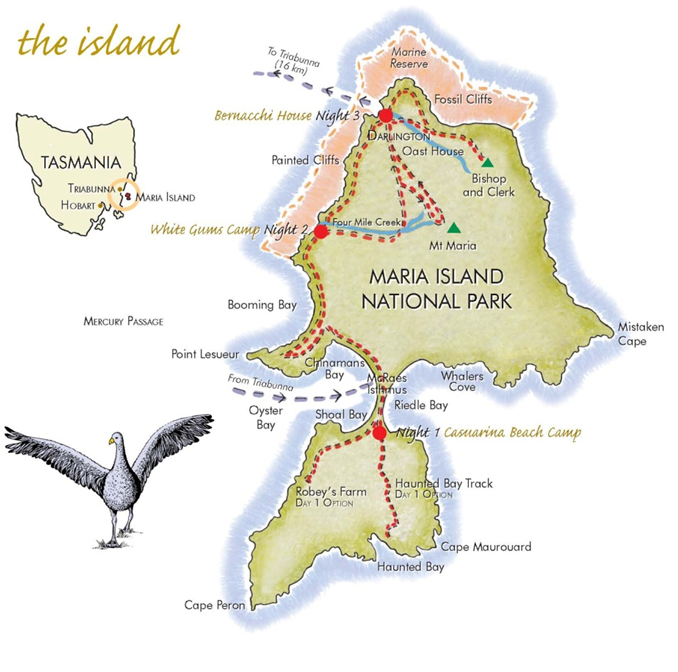Tasmania Sport & Adventure
Wild and Free: Hiking Maria Island in Tasmania


Hiking boots laced, Kelly Allen discovers Maria Island, a floating national park showcasing Tasmania’s abundant natural beauty and renowned flavours
Grilled Dunalley farm quail, duck and wallaby sausage from Sandy Bay, and crispy Huon salmon fillets; would you believe me if I told you I was on a wilderness hike in Tasmania? On the state’s east coast, just a 25-minute boat ride from Triabunna Harbour, lies Maria Island, rich in natural beauty and native animals, and with a colourful convict past. Some choose the DIY-style hike, which means bringing your own supplies to the island (there are no shops or residents here) and carting them around on a self-guided tour. But I have decided to spend the next four days enjoying the comforts of a permanent bush camp, gourmet meals, open-air hot showers, and surprisingly civilised composting toilets.
The Maria Island Walk is one of just 11 in the Great Walks of Australia Signature Collection. Our guides, Holly and Ella, are enthusiastic about the history of the area and share their knowledge of the native plants and animals, including the tiger snake and copperhead we come across (a highlight for me, believe it or not). Wombats are everywhere and, like the snakes, are indifferent to hikers, barely giving us a glance as we creep up close for a photo opportunity. As part of a population regeneration program, the island is home to more than 100 Tasmanian Devils, although they all unfortunately avoided us.
Our first day is a gentle 10 kilometres with a picnic lunch upon arrival to camp, followed by a hike to Haunted Bay on the south end of the island. We leave our large packs at camp, just bringing cameras and water, so it’s not a strenuous walk. We have some rain, making me glad I said yes to the warm raincoats offered before we started.
Any potential of dropping a kilo or two during these long walks on the island quickly disappears as Holly and Ella boast incredible cooking skills. When we return to camp, we change into dry clothes and enjoy an array of Tasmanian cheeses, pickled onions, olives and fig paste paired with local beer and wine. Dinner starts with a freshly made bruschetta on sourdough bread, followed by a seafood risotto with asparagus and local scallops. Dessert is fresh berries with crumbled meringue and thickened cream. It’s not your typical camp fare, but I’m certainly not complaining. Food allergies are catered for and meal alternatives are just as delicious and thoughtfully prepared.
There’s a pleasant vibe around the dining table as our group of nine relaxes and gets to know each other. We are a diverse group of singles and couples plus a family with a 12-year-old daughter. We’re all Australians here to explore the beauty of our own backyard.
The second day is a bit more challenging as we walk 14 kilometres with our packs (most weigh about nine kilograms; the guides carry about 23 kilos). Lucky for us, the girls have fed us well at breakfast. Fuelled up on scrambled eggs with smoked salmon, sourdough toast, yogurt, fresh fruit, granola, tea and plunger coffee, we feel energised to push on. This day is known as ‘five beaches day’ and it’s spent walking along quiet shorelines and enjoying a swim in the clear water whenever we fancy. The water is a comfortable 18°C.
The pace is relaxed with breaks for tea and biscuits every now and again. There’s never a feeling of being rushed, and the group settles into a nice rhythm with one guide toward the front and one bringing up the rear.
We arrive at White Gums camp mid-afternoon. Below us is Four Mile Beach, a secluded stretch of sand and not a soul to be seen. It’s a perfect spot for an afternoon swim followed by a short siesta. That evening, the girls are again intent on making sure we’re rewarded for all that walking. We dine on miso and wild mushroom soup, ratatouille, grilled honey soy quail, lamb cutlets, gourmet sausages, and flourless chocolate cake.
On day three, after a pancake breakfast (including a delicious vegan and gluten free version), we hike an easy six kilometres to the next site, Bernacchi House, located in the World Heritage-listed convict settlement of Darlington. The beautifully restored homestead was built in 1880 and is surrounded by a lavender garden, which the wombats seem to enjoy snacking on. After lunch we are given the afternoon options: a leisurely wander around the settlement of Darlington or the rigorous climb up twin peaks Bishop and Clerk.
Our entire group decides to take up the challenge, which takes us along rugged cliff tops, through open forest, up rocky slopes and finally, to the summit. There is some boulder hopping and scrambling as you near the top, and if you are afraid of heights, you may want to stop just short as the drop could prove tummy churning. But if you do make it to the top, the vista – a bird’s-eye-view of the Freycinet Peninsula, Schouten Island, Isle des Phoques, and the east coast of Tasmania – is indescribable. The only group there, we took time to appreciate this beautiful moment, as well as the chocolate bars Ella had surprised us with – an apt reward for the five-hour return trip. Likewise the crispy salmon with potato and dill mash, and light lemon tart we enjoyed that evening.
Our last day was spent exploring the convict settlement with – thankfully – time for one last meal before heading back to the mainland. Gourmet sandwiches on just-baked bread courtesy of Holly, Bruny Island oysters and local bubbles: inviting and utterly satisfying, not unlike our journey.
Latest Articles
Don't miss the latest from Luxury Travel

